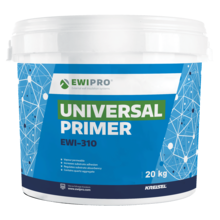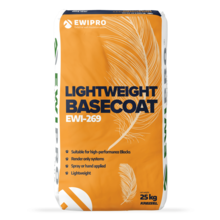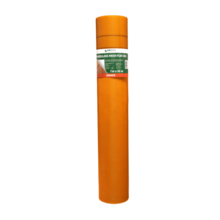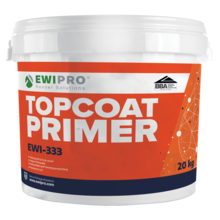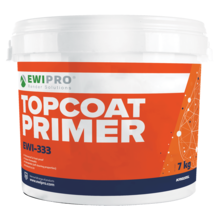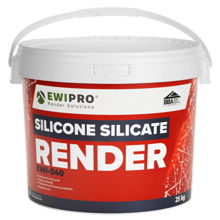
Blockwork or block wall is a type of substrate composed of concrete or cement blocks. It is a cost-effective and high-performing means of structurally supporting your property. Yet, rendering onto blocks can be an effective way to add further structural integrity to the wall.
When rendering onto blockwork, there are several steps that you should take to achieve the perfect finish.
We have created a handy complete guide to equip you with all the knowledge you will need to understand the process of how to apply render to blockwork.
1. Priming the Substrate
When installing render onto block, you should be sure to prime it correctly. This ensures the new render will last by aiding adhesion between the basecoat layer and the block. For the primer, we recommend using a roller or brush to apply the EWI-302 Deep Penetrating Primer as it is ideal for stabilising the walls. EWI-302 has a coverage rate of 5L/20m2 and a drying time of 4 hours per coat.
However, if you are rendering onto a smooth substrate, we recommend using EWI-310 Universal Primer. This creates an abrasive surface for the parge / basecoat to adhere to.
EWI-310 Universal Primer’s coverage is 5L/20m2 and has a drying time of 4 hours per coat.
2. Applying a Parge Coat
If the substrate surface is uneven, we recommend adding a parge coat layer. In this instance, we suggest using our EWI-269 Lightweight Basecoat. EWI-269 is highly breathable, strong and heritage-friendly.
When it comes to new builds, the walls are generally completely level, or the mortar joints' height are less than 10mm. In these instances, we recommend applying 2mm of EWI-225 for the parge coat.
3. Applying the Beading
A further key component of the rendering onto blockwork process is beading. Beading works to reinforce certain areas on the external wall that are more prone to damage.
The beads you will require will depend on the areas that need reinforcing. For example, windows, doors and corners.
Our selection of available render beads allows you to choose the perfect beading for your property. They are comprised of uPVC and are designed to be embedded in the basecoat layer.
4. Preparing the Basecoat
If you are rendering onto blockwork, you will require the use of EWI’s strongest adhesive. At this stage in the installation process, we would heavily recommend you use EWI-225 Premium Basecoat.
Simply use a paddle mix to mix the contents of the bag with 5.9L of water - leave the mixed product for 5 minutes and then give the product a final mix just prior to application.
1 bag of EWI-225 covers 3.5m2 and has a drying time of 24-48 hours.
5. Applying the Basecoat Layer and Embedding the Mesh
When applying the EWI-225 Basecoat layer when rendering onto blockwork, use an 10mm notched trowel. From there, embed fibreglass mesh to create the reinforced flexible basecoat layer. This layer reinforces the system with a strong, flexible and waterproof base.
At EWI store, we offer two high strength meshes to suit your individual project’s needs. Both meshes are coated with acrylic acid copolymer liquid for a long-lasting effect. Below is a breakdown of each mesh’s capabilities:
1) Orange Fibreglass Mesh: for guaranteed strength and flexibility. This mesh is water resistant
and protects against alkali damage and aging. 1 x 50m2 roll covers 42.5m2 when overlapped.
2) Panzer Fibreglass Mesh: our strongest mesh available guarantees a premium level of impact
and crack resistance against the elements. Each roll is25m2 and will cover 22.5m2 when overlapped.
6. Priming the Basecoat Before Rendering
Once the mesh has been embedded within the basecoat, and the basecoat has been left to cure, your next port of call should be to prime it before rendering.
Priming the basecoat does 2 main things - firstly it helps aid adhesion between the render and the basecoat. It also helps process limit absorption of the basecoat. Our EWI-333 Topcoat Primer is designed specifically for this purpose and can be tinted to match the colour of your silicone render.
EWI-333 has a drying time of 12-24 hours, depending on the coverage. Its coverage rates are listed below:
- 7kg = 20m2
- 20kg = 60m2
7. Applying Silicone Render
The final step in applying render onto blockwork is to apply the render once the Topcoat Primer has dried.
Since most of our renders are thin coat renders, the thickness of the topcoat depends on the grain size of the render. Our most popular render is our EWI-075 silicone render, which is available with a grain size of 1mm, 1.5mm, 2mm and 3mm. If you were to purchase the 2mm Silicone Render, your topcoat should be applied no thicker than 2mm.
Render should be applied using a trowel. Any excess render should always be removed. Use a plastic float to apply the render in a circular motion for your desired finish.
Below are the various coverage rates you can expect from different grain sizes:
- 1.0mm = 12m2 - 13m2
- 1.5mm = 9m2 - 10m2
- 2.0mm = 7m2 - 8m2
- 3.0mm = 5m2 - 6m2
Download our Complete Guides
All products mentioned are available in the EWI Store. If you have any further questions, our Sales team will be happy to assist on 0203 034 00 22.
You can download a copy of our complete guide below.

